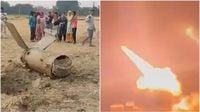On November 20, 2025, the already simmering tensions between India and Pakistan took another dramatic turn. In a series of interviews and public remarks, key figures from both nations—alongside former US President Donald Trump—offered sharply contrasting narratives about the risk of war, the role of international mediation, and the specter of nuclear conflict in South Asia. The region, already on edge from recent attacks and border clashes, now finds itself in the global spotlight, with leaders trading warnings and credit for averting catastrophe.
Pakistan’s Defence Minister Khwaja Asif was blunt in his assessment of the current situation. Speaking to local media, Asif warned, “We are neither ignoring India nor trusting it under any circumstances. Based on my analysis, I cannot rule out an all-out war or any hostile strategy from India, including border incursions or attacks (presumably Afghan). We must stay fully alert.” His comments, reported by The Economic Times, reflected a heightened state of vigilance in Islamabad, especially following a deadly car explosion in New Delhi on November 10 that killed 15 people, and a prior attack in Pahalgam earlier in the year.
Asif’s warnings were not made in a vacuum. Just days earlier, Indian Army Chief General Upendra Dwivedi described India’s Operation Sindoor—launched in May 2025 after the Pahalgam attack—as an “88-hour trailer.” According to General Dwivedi, the Indian armed forces were prepared to “teach them [Pakistan] how to behave responsibly with a neighbouring nation” if required. This rhetorical escalation has only added to the sense of unease in the region, where memories of past conflicts linger and the threat of violence is never far from the surface.
For Pakistan, the sense of encirclement is palpable. Asif emphasized that his country is prepared to face simultaneous challenges on both its eastern (India) and western (Afghanistan) borders. “We are ready; we are prepared to face both the eastern (India) and western (Afghanistan) borders. Allah helped us in round one, and He will help us in round two,” he said. “If they want the final round, we have no option but war.” These remarks, delivered with a mix of bravado and fatalism, underscore the gravity with which Pakistani officials view the current security environment.
But the plot thickens when the Afghanistan factor is considered. In October 2025, heavy fighting broke out between Pakistani forces and the Taliban regime, resulting in casualties on both sides. The violence was only halted after Turkey and Qatar brokered a ceasefire on October 19. Yet, Asif has repeatedly suggested that India is playing a destabilizing role by supporting attacks originating from Afghan territory. Speaking to Geo News, he stated, “I have my doubts that the ceasefire will hold, because the decisions of the [Afghan] Taliban are being sponsored by Delhi.” These allegations, while unproven, reflect Islamabad’s deep-seated suspicions about Indian intentions and the complex web of alliances and enmities in the region.
Meanwhile, across the globe in the United States, former President Donald Trump offered his own, characteristically theatrical, version of events. Addressing the US Saudi Investment Forum, Trump claimed personal credit for preventing a nuclear confrontation between India and Pakistan. “You know, I was talking about the different wars, and it’s, look, India, Pakistan, they were going to go out with nuclear weapons. I said, that’s okay, you can go at it, but I’m putting a 350 percent tariff on each country, no more trade with the United States,” Trump recounted, as reported by ANI.
According to Trump, his threat of crippling economic sanctions forced both sides to reconsider. He recalled, “One of the sides responded, ‘No, no, you can’t do that.’ I said, ‘I’m going to do it. Come back to me and I’ll take it down. But you, I’m not going to have you guys shooting nuclear weapons at each other, killing millions of people and having the nuclear dust floating over Los Angeles. I’m not going to do it.’” Trump’s narrative, peppered with his trademark bravado, suggests that economic leverage—rather than military might—was the key to defusing the crisis.
Trump went further, claiming that Pakistani Prime Minister Shehbaz Sharif personally thanked him “for saving millions of lives,” and that Indian Prime Minister Narendra Modi agreed to halt any plans for war. “He actually said, I saved millions. And he said in front of Susie, he said President Trump saved millions and millions of lives,” Trump asserted. He continued, “And I got a call from Prime Minister Modi saying, we’re done. I said, you’re done with what? ‘We’re not going to go to war.’ I said, Thank you very much. Let’s make a deal.”
Following the brief, four-day confrontation between India and Pakistan in May 2025—sparked by the Pahalgam terror attack that killed 26—Trump announced on social media that both countries had agreed to a “full and immediate ceasefire” after what he described as a “long night” of US-mediated discussions. He has since repeated his claim to have “helped settle” the tensions between the nuclear-armed neighbors.
The response from the subcontinent, however, has been anything but unanimous. While Pakistan has publicly credited Trump for helping broker the ceasefire during the May conflict, India has consistently denied any third-party involvement. This divergence in public statements reflects a broader pattern: Islamabad, facing mounting security challenges and international pressure, has often welcomed outside mediation, whereas New Delhi has traditionally insisted on bilateral dialogue and rejected external interference in its disputes with Pakistan.
For observers, the competing narratives raise important questions. Did Trump’s threat of tariffs truly tip the scales, or were regional dynamics and direct talks the decisive factors? Is Pakistan’s focus on Indian involvement in Afghanistan a reflection of genuine intelligence, or a means of rallying domestic support? And, perhaps most urgently, how close did the region come to the brink of war—and could it happen again?
What’s clear is that the stakes remain perilously high. The recent attacks in New Delhi and Pahalgam, the specter of cross-border violence, and the unresolved tensions along the Afghanistan-Pakistan frontier all point to a region where peace is fragile and the risk of escalation ever-present. As regional leaders trade warnings and international figures like Trump claim credit for averting disaster, ordinary citizens on both sides of the border are left hoping that cooler heads will prevail.
In the end, the latest round of rhetoric and recrimination serves as a sobering reminder of just how quickly South Asia’s security environment can shift from tense calm to potential catastrophe. With mistrust running deep and the possibility of miscalculation always lurking, the world will be watching closely for any sign that the uneasy peace might once again give way to conflict.




